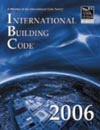2303.2.1 Labeling. Fire-retardant-treated
lumber and wood structural panels shall be labeled. The
label shall contain the following items:
1.The identification mark
of an approved agency in accordance with Section
1703.5.
2. Identification of the
treating manufacturer.
3. The name of the fire-retardant
treatment.
4. The species of wood treated.
5. Flame spread and smoke-developed
index.
6. Method of drying after
treatment.
7. Conformance with appropriate
standards in accordance with Sections 2303.2.2 through
2303.2.5.
8. For fire-retardant-treated
wood exposed to weather, damp or wet locations, include
the words “No increase in the listed classification
when subjected to the Standard Rain Test” (ASTM D
2898).
2303.2.2 Strength adjustments.
Design values for untreated lumber and wood structural panels,
as specified in Section 2303.1,
shall be adjusted for fire-retardant- treated wood. Adjustments
to design values shall be based on an approved method of
investigation that takes into consideration the effects
of the anticipated temperature and humidity to which the
fire-retardant-treated wood will be subjected, the type
of treatment and redrying procedures.
2303.2.2.1 Wood structural
panels. The effect of treatment and the method of
redrying after treatment, and exposure to high temperatures
and high humidities on the flexure properties of fire-retardant-treated
softwood plywood shall be determined in accordance with
ASTM D 5516. The test data developed by ASTM D 5516 shall
be used to develop adjustment factors, maximum loads and
spans, or both, for untreated plywood design values in
accordance with ASTM D 6305. Each manufacturer shall publish
the allowable maximum loads and spans for service as floor
and roof sheathing for its treatment.
2303.2.2.2 Lumber.
For each species of wood that is treated, the effects
of the treatment, the method of redrying after treatment
and exposure to high temperatures and high humidities
on the allowable design properties of fire-retardant-treated
lumber shall be determined in accordance with ASTM D 5664.
The test data developed by ASTM D 5664 shall be used to
develop modification factors for use at or near room temperature
and at elevated temperatures and humidity in accordance
with ASTM D 6841. Each manufacturer shall publish the
modification factors for service at temperatures of not
less than 80°F (27°C) and for roof framing. The roof framing
modification factors shall take into consideration the
climatological location.
2303.2.3 Exposure to weather,
damp or wet locations. Where fire-retardant-treated
wood is exposed to weather, or damp or wet locations, it
shall be identified as “Exterior” to indicate
there is no increase in the listed flame spread index as
defined in Section 2303.2 when subjected to ASTM D 2898.
2303.2.4 Interior applications.
Interior fire-retardant- treated wood shall have moisture
content of not over 28 percent when tested in accordance
with ASTM D 3201 procedures at 92-percent relative humidity.
Interior fire-retardant-treated wood shall be tested in
accordance with Section 2303.2.2.1 or 2303.2.2.2. Interior
fire-retardant- treated wood designated as Type A shall
be tested in accordance with the provisions of this section.
2303.2.5 Moisture content.
Fire-retardant-treated wood shall be dried to a moisture
content of 19 percent or less for lumber and 15 percent
or less for wood structural panels before use. For wood
kiln dried after treatment (KDAT), the kiln temperatures
shall not exceed those used in kiln drying the lumber and
plywood submitted for the tests described in Section 2303.2.2.1
for plywood and 2303.2.2.2 for lumber.
2303.2.6 Type I and II construction
applications. See Section 603.1
for limitations on the use of fire-retardant- treated wood
in buildings of Type I or II construction.

